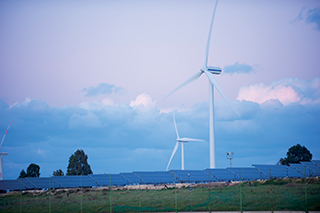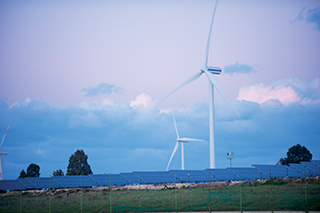

Renewables rising
Eric Peterson //February 6, 2014//
 A sea change in electrical generation is underway in Colorado.
A sea change in electrical generation is underway in Colorado.
Xcel Energy has received approval to add 170 megawatts of solar, 450 megawatts of wind and 317 megawatts of natural gas generation, while phasing out a coal plant in Denver earlier than originally planned.
It all adds up to a major shift in the company’s resource portfolio for electricity in Colorado.
The Colorado Public Utilities Commission (PUC) approved the plan last December. PUC Chairman Joshua Epel called the approval “an historic moment” for its impact on carbon emissions and a sign of price parity between renewables and fossil fuels. The decision is effective through 2018.
But the move isn’t just about going green. Gabriel Romero, Xcel spokesperson, says the plan was driven by economics first and foremost.
“We can get wind and solar for a comparable price as coal and gas,” says Romero. “That’s a good business decision.”
Perhaps surprisingly, this decision has nothing to do with the Colorado state mandate that 30 percent of electricity come from renewable resources by 2020. Xcel expects to hit that target several years in advance.
“We’re already compliant; we’re going to hit the mandate,” Romero says. “Any decision we make with renewable energy moving forward is a business decision.”
The utility supplier is working on power purchase agreements for the more than 600 megawatts of solar and wind energy covered by the plan with energy producers and project developers. The new capacity will come online in “about a year,” Romero projects.
“We’re able to bring wind into our system because we have a pretty broad system,” says Romero. “We’re able to handle that new load. We have no problem bringing in 500 megawatts of wind, but smaller utilities aren’t able to do it.”
Because of the unpredictable nature of wind and solar, additional gas-based generation is critical, says Romero. “When you bring in renewable energy, you’re going to have to be able to turn up and down your generation plants,” he explains. “That only works with gas. That doesn’t work with coal. It all works in coordination with everything else. All of that coordination makes it come in cost-competitively, and that includes solar. That’s unheard of up to this point.”
Because throttling down a coal plant in response to wind speeds or cloud cover is not possible, “You’re likely to have to throw some of that power away,” Romero says. “Therein lies the trick – you have to turn one thing down.”
With natural-gas prices hovering near all-time lows, is the trick still possible if prices track closer to historical norms? “It’s always been a volatile resource,” Romero says. “Our forecasts don’t indicate it’s going to have a major uptick in price.”
Rooftop solar remains far from grid parity. “Solar has never been cost-competitive,” says Romero. However, “They’re figuring it out.” Expect a boom in large-scale solar farms, he adds. “You’re going to start seeing changes all over the place.”
Colorado is in a good position, literally and figuratively, for renewable energy. There’s plenty of wind to the north and east, the oft-touted 300 sunny days a year, and a cooler climate that’s more favorable to solar generation than, say, Arizona; 100 degree heat is not conducive to efficient solar generation.
“We happen to be in a good state for renewable energy, everything really,” Romero says. “Coal is close; we have excellent wind and good transmission. Transmission is wind’s destroyer.” He also points to a “bipartisan willingness” to adopt renewable energy, a rarity in today’s commonly polarized political climate. “It’s been less controversial than it has been in other states,” Romero says.
“People like to look at this as one versus the other, but that’s not the way it works,” he says. “It’s not either this or that – it’s this and that. As a utility, we always are looking for a diverse portfolio. We’re not against anything. You can’t put all of your eggs in one basket.”
























